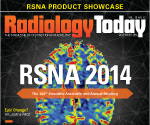 |
 |
During a lunchtime discussion with several radiologists at RSNA, one doctor asked if anyone at the table knew of any good examples of comanagement agreements between radiology groups and hospitals. The group members shrugged their shoulders.
About 90 minutes later, by pure coincidence, I heard the story of the comanagement arrangement between Aultman Hospital’s imaging department and Radiology Associates of Canton (Ohio) in a session designed for hospital administrators, which the subject of this month’s E-News Exclusive.
— Jim Knaub, editor |
 |
 |
Comanagement: In Your Future?
By Jim Knaub
In this changing health care environment, many radiology groups worry about maintaining their autonomy and security. At the same time, hospital leaders want to provide quality imaging services and feel secure that their radiologists’ goals align with the hospital’s objectives. Finding a space that satisfies both can be a challenge.
For some groups, a formal comanagement agreement offers a good solution. Radiology groups can maintain their independence while hospitals can improve control over quality and management concerns. Syed F. Zaidi, MD, of Radiology Associates of Canton (Ohio), and Christopher E. Remark, MBA, CEO of Aultman Hospital in Canton, talked about the arrangement between their organizations at the Hospital Administrators Symposium at RSNA 2014 in Chicago.
Full story » |
 |
 |
‘Virtual Breast’ Could Improve Cancer Detection
According to a press release from Michigan Technical University, researchers developed a “virtual breast” that allows clinicians to practice reading ultrasound elastography results in order to greatly increase accuracy.
New Imaging System May Cut X-ray Exposure for Liver Cancer Patients
Researchers report that an interventional X-ray guidance device approved by the FDA in 2013 has the potential to reduce the radiation exposure of patients undergoing intra-arterial therapy for liver cancer, according to a press release from Johns Hopkins.
Researchers Discover Possible Cause of Common Dementia
By studying CT and MR images of older patients, researchers at Krembil Neuroscience Centre in Toronto, Ontario, Canada, believe they may have discovered a possible cause of dementia, according a press release.
Real-Time Tracking System Monitors Dangerous Bacteria Inside the Body
Combining a PET scanner with a new chemical tracer that selectively tags specific types of bacteria, Johns Hopkins researchers working with mice report they have devised a way to detect and monitor in real time infections with a class of dangerous Gram-negative bacteria, according to a press release. |
 |
|
|
 |
Ultrasound-Accelerated Thrombolysis
A recent study has shown no significant advantages to using ultrasound-accelerated thrombolysis over the current standard, catheter-directed thrombolysis. Read more »
Epic Change?
More and more people are trying to decide whether to utilize RIS/EMR or not. Increasingly, the answer seems to be affirmative, thanks in large part to Epic's Radiant RIS. For health care organizations that already use Epic's EMR, the lure of Radiant can be hard to resist. Read more »
Reporter's Notebook: ASTRO 2014
Learn about the latest research findings presented at the American Society for Radiation Oncology's 56th annual meeting, held in San Francisco in September. Read more »
Radiology Today Interview: Tobias Gilk — Setting Up an MRI Safety Program
(Part 2 of 2)
MRI expert Tobias Gilk discusses a variety of topics related to safety and best practices in the final installment of this exclusive two-part interview with Radiology Today. Read more » |
 |
|
